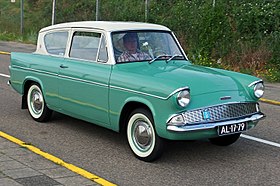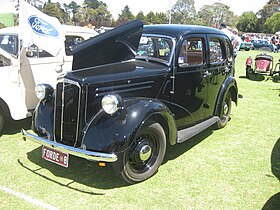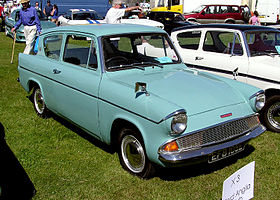Ford Anglia
| Ford Anglia | |
|---|---|

1960 Ford Anglia 105E DeLuxe
|
|
| Overview | |
| Manufacturer | Ford UK |
| Production | 1939–67 |
| Assembly |
Dagenham, England Halewood, England from 1963 Australia |
| Body and chassis | |
| Class | Small family car (C) |
| Layout | Front-engine, rear-wheel-drive |
| Chronology | |
| Predecessor | Ford 7Y |
| Successor | Ford Escort |
| Ford Anglia E04A | |
|---|---|

1946 Ford Anglia E04A 2-door saloon
|
|
| Overview | |
| Production | 1939–48 55,807 units |
| Assembly | United Kingdom Australia |
| Body and chassis | |
| Body style | 2-door saloon 2-door tourer (Australia) 2-door roadster (Australia) |
| Related | Ford Prefect |
| Powertrain | |
| Engine | |
| Dimensions | |
| Wheelbase | 90 in (2,286 mm) |
| Length | 152 inches (3,861 mm) |
| Width | 57 in (1,448 mm) |
| Height | 63 in (1,600 mm) |
| Ford Anglia A54A | |
|---|---|

1948 Ford Anglia A54A 4-Door Sedan
|
|
| Overview | |
| Production | 1946–48 |
| Assembly | Australia |
| Body and chassis | |
| Body style | 4-door sedan 2-door tourer 2-door coupe utility 2-door panel van |
| Powertrain | |
| Engine | 933 cc (56.9 cu in) I4 |
| Ford Anglia E494A | |
|---|---|

1953 Ford Anglia E494A
|
|
| Overview | |
| Production | 1949–53 108,878 units |
| Body and chassis | |
| Body style | 2-door saloon 2-door panel van |
| Powertrain | |
| Engine | 933 cc (56.9 cu in) I4 |
| Transmission | 3 speed manual |
| Dimensions | |
| Wheelbase | 90 in (2,286 mm) |
| Length | 154 in (3,912 mm) |
| Width | 57 in (1,448 mm) |
| Height | 63 in (1,600 mm) |
| Ford Anglia A494A | |
|---|---|

1951 Ford Anglia A494A Tourer
|
|
| Overview | |
| Production | 1949–53 |
| Assembly | Australia |
| Body and chassis | |
| Body style | 4-door saloon 2-door tourer 2-door coupe utility 2-door roadster utility |
| Related | Ford Popular |
| Powertrain | |
| Engine | 933 cc (56.9 cu in) I4 1,172 cc (71.5 cu in) I4 |
| Ford Anglia 100E | |
|---|---|

1955 Ford Anglia 100E
|
|
| Overview | |
| Production | 1953–59 345,841 units |
| Assembly | United Kingdom Australia |
| Body and chassis | |
| Body style | 2-door saloon |
| Related |
Ford Popular 100E Ford Prefect 100E Ford Escort 100E (estate) Ford Squire 100E (estate) Thames 300E (van) |
| Powertrain | |
| Engine | 1172 cc sidevalve Straight-4 |
| Dimensions | |
| Wheelbase | 87 in (2,210 mm) |
| Length | 151.75 in (3,854 mm) |
| Width | 60.5 in (1,537 mm) |
| Height | 57.25 in (1,454 mm) |
| Curb weight | 1,624 lb (737 kg) |
| Ford Anglia 105E | |
|---|---|

1967 Ford Anglia 105E
|
|
| Overview | |
| Production | 1959–67 1,004,737 units |
| Assembly |
|
| Body and chassis | |
| Body style | 2-door saloon 3-door estate car 2-door panel van |
| Powertrain | |
| Engine | 997 cc (60.8 cu in) OHV I4 |
| Dimensions | |
| Wheelbase | 90.5 in (2,299 mm) |
| Length | 154 in (3,912 mm) |
| Width | 56 in (1,422 mm) |
| Height | 56 in (1,422 mm) |
| Curb weight | 1,624 lb (737 kg) (saloon) |
| Ford Anglia Torino 105E | |
|---|---|

Ford Anglia Torino 105E
|
|
| Overview | |
| Production | 1965–67 |
| Assembly |
Italy Belgium |
| Body and chassis | |
| Body style | 2-door saloon |
| Powertrain | |
| Engine | 997 cc I4 |
| Ford Anglia Super 123E | |
|---|---|

1966 Ford Anglia Super 123E Sedan
|
|
| Overview | |
| Production | 1962–67 79,223 units |
| Body and chassis | |
| Body style | 2-door saloon 3-door estate car 2-door panel van |
| Powertrain | |
| Engine | 1198 cc I4 |
The Ford Anglia was a compact car that was designed and manufactured by Ford UK. It is related to the Ford Prefect and the later Ford Popular. The Anglia name was applied to various models between 1939 and 1967.
A total of 1,594,486 Anglias were produced. It was replaced by the Ford Escort.
The patriotically named first Ford Anglia, launched soon after Britain declared war on Germany in early September 1939, and given the internal Ford model code of E04A, was a facelifted version of the Ford 7Y, a simple vehicle aimed at the cheap end of the market, with few features. Most were painted Ford black. Styling was typically late-1930s, with an upright radiator. There were standard and deluxe models, the latter having better instrumentation and, on pre-war models, running boards. Both front and rear suspensions used transverse leaf springs, and the brakes were mechanical.
The two-door Anglia is similar to the longer, four-door, E93A Ford Prefect. A bulge at the back enabled a spare wheel to be removed from its vertical outside stowage on the back of the car and stowed flat on the boot floor, which usefully increased luggage space. Some back seat leg room was sacrificed to the luggage space, being reduced from 43¾ inches in the Ford 7Y to 38½ inches in the Anglia. The Anglia replaced the 7Y saloon, but the van version of the earlier model continued to be built until 1946, after which some very minor changes sufficed to rebaptize the van the "E04C".
The domestic market engine was the 933 cc (56.9 cu in) straight-four side-valve engine familiar to drivers of predecessor models since 1933. The 1172 cc straight-four engine from the Ford Ten was fitted for some export markets, including North America, where imports began for model year 1948; these cars used the slightly more aerodynamic "three-hole" grille from the 1937-38 Ford Ten 7W, prefacing the 1949 E494A facelift. They also had sealed beam headlights and small, separate parking lights mounted underneath, as well as dual tail lights, into which flashing turn signals could be added without adding additional lights. A minor styling change was made in December 1947, with the name “Anglia” now incorporated in the top of the grille surround.
...
Wikipedia
